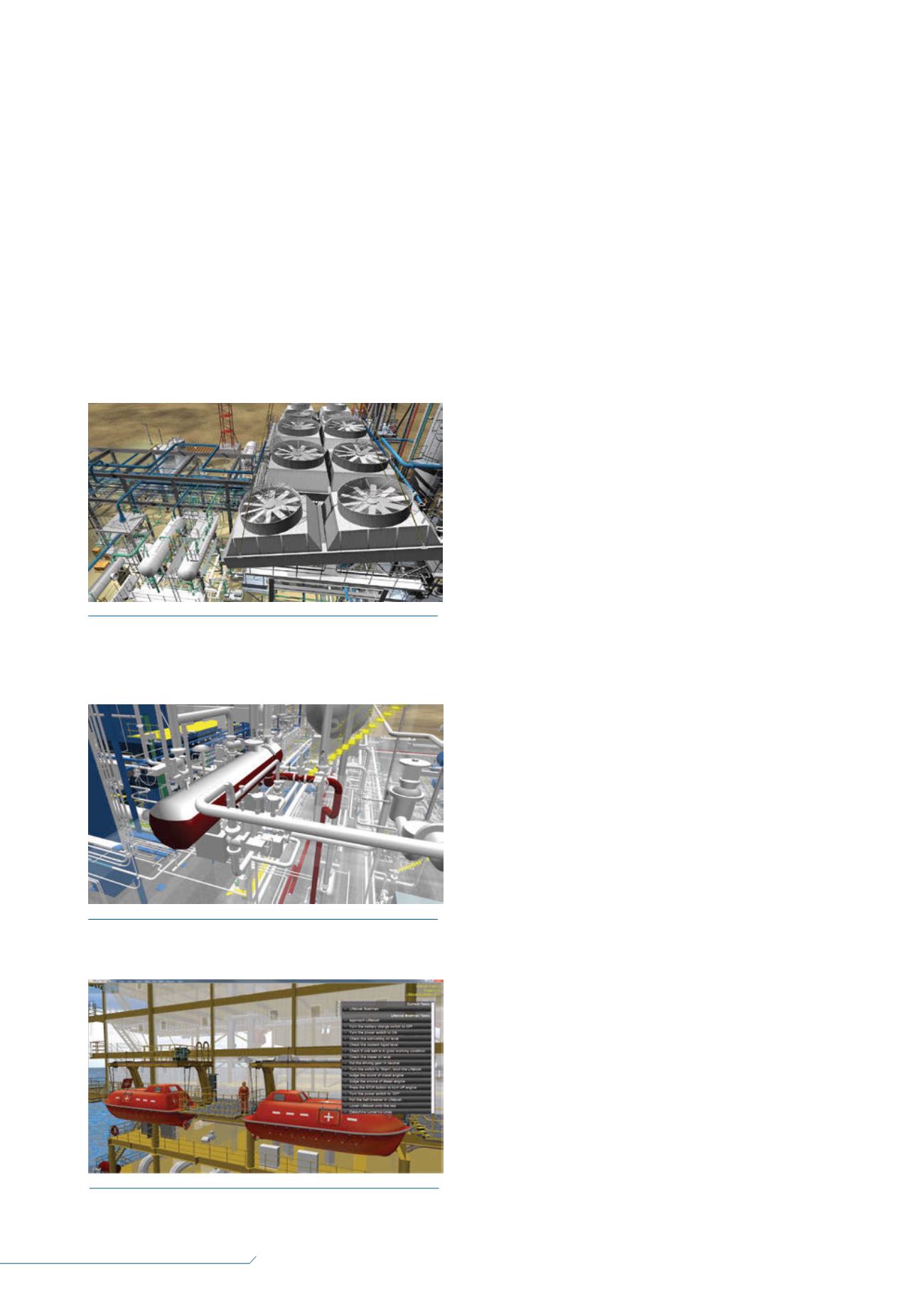
96
LNG
INDUSTRY
MARCH
2016
People learn best by doing, especially when they are allowed
tomake mistakes. However, in many situations, a mistake can be
catastrophic. This is why immersive simulation, such as the
modern flight simulator, is so effective. Being able to learn new
skills, or to refresh one’s memory by rehearsing infrequent,
complex or hazardous tasks in the safety of the virtual world,
results in improved safety and efficiency in the real world. Not
surprisingly, therefore, operators are requesting, or even
mandating, immersive training environments for their vessels and
facilities.
Nonetheless, creating such environments is not a trivial
exercise; the virtual vessel or facility must faithfully represent the
real as-operated one. The first need, therefore, is an efficient way
of translating a 3D design model into a simulation environment.
This has been one of AVEVA’s priority developments, so that
today, a model created in the industry-standard AVEVA PDMS™,
AVEVAMarine™or AVEVA E3D™ solutions, can be readily
converted, not just into a passive replica, but into one in which
valves turn, switches switch and objects can be unbolted and
replaced. Ongoing development is now focused on ways tomake
it quicker and easier to keep the simulation model up to date with
the many continual changes that the real facility undergoes
throughout its working life. Looking further ahead, developments
are beingmade to exploit 3D laser scanning technologies to
create andmaintain interactive simulations of facilities for which a
design model does not exist.
There are potential limitations from the sheer size and
complexity of many modern engineering assets. AVEVA’s 3D
design and visualisation technology can support plant or ship
models of unlimited size. As a result, AVEVA AVP has no practical
limitations on model complexity.
In-game project information
Users need to capture functional interactions from the engineering
or design intent and to embed these relationships between
objects in the simulation. For example, in a lock-out/tag-out
scenario, closing a valve or isolating a switch must be reflected
both in any corresponding indicators and in the behaviours
of connected objects. Achieving this requires information
contained in schematic sources to be used, such as piping
and instrumentation design (P&IDs) or single-line diagrams.
Again, manual translation of such information can be costly and
error-prone, so automating this is important both for the original
creation of a simulation and for its long-termmaintenance.
For an effective user experience, it is desirable to be able to
access asset information fromwithin the immersive training
environment itself, rather than having to jump out into other
programs or information sources. Typical examples would be a
drawing, a maintenance procedure for a piece of equipment, or a
P&ID to verify the correct valve to close. In AVEVA AVP, this is
implemented in the formof an in-game browser that can be
opened as required to view any available online information,
simulating the use of a ruggedised tablet device when on site.
What makes this feature particularly valuable is the potential that
it offers for creating structured, interactive e-learning exercises for
operator training.
Immersive training experience
There is considerable interest in the oil and gas industry for the
integration of process simulation with immersive training. This
could increase the realismof many scenarios. For example, an
operation, such as restarting a process or a main engine, could
have the simulated plant behave exactly as the real one would,
with vessels filling at realistic rates, or pressures and temperatures
exceeding safe limits if the restart is fumbled by a trainee
operator. It would also enable better analysis of hazards and
incidents.
The effectiveness of 3Dmetaphors for accessing information
is driving a steady convergence between different solutions. For
example, the newAVEVA Engage™decision-support solution
combines real-time navigation of a complex 3Dmodel with
powerful information management technology to enable a user
to drill down to any level of information about any object.
Furthermore, ‘In Context Technology’ presents directly relevant
object information to a designer or engineer within their design
solution itself. So, one can expect to see immersive training and
simulation also being underpinned with information management
that provides increasingly better access tomore of a facility’s
digital asset. The potential exists to begin creating an
immersive simulation at an early stage of design development
Figure 1.
An illustration from a training exercise in AVEVA AVP.
The realistic objects were created directly from the AVEVA PDMS
3D design model and accurately exhibit properties such as weight
and inertia.
Figure 2.
Process animation in an interactive AVEVA AVP
simulation (model courtesy of CNOOC).
Figure 3.
Rehearsing correct lifeboat handling in AVEVA AVP
(model courtesy of CNOOC).


